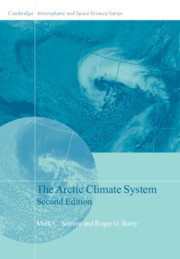Book contents
- Frontmatter
- Dedication
- Contents
- Preface
- Acknowledgments
- List of Acronyms
- List of Selected Web Sites
- 1 The Evolution of Knowledge about the Arctic and Its Climate
- 2 Physical Characteristics and Basic Climatic Features
- 3 The Basic Atmospheric and Ocean Energy Budgets
- 4 The Atmospheric Circulation
- 5 Energy Exchanges at the Surface
- 6 Precipitation, Net Precipitation, and River Discharge
- 7 Arctic Ocean–Sea Ice–Climate Interactions
- 8 Climate Regimes of the Arctic
- 9 Modeling the Arctic Climate System
- 10 Arctic Paleoclimates
- 11 The Uncertain Future
- References
- Index
- Plate Section
9 - Modeling the Arctic Climate System
Published online by Cambridge University Press: 05 August 2014
- Frontmatter
- Dedication
- Contents
- Preface
- Acknowledgments
- List of Acronyms
- List of Selected Web Sites
- 1 The Evolution of Knowledge about the Arctic and Its Climate
- 2 Physical Characteristics and Basic Climatic Features
- 3 The Basic Atmospheric and Ocean Energy Budgets
- 4 The Atmospheric Circulation
- 5 Energy Exchanges at the Surface
- 6 Precipitation, Net Precipitation, and River Discharge
- 7 Arctic Ocean–Sea Ice–Climate Interactions
- 8 Climate Regimes of the Arctic
- 9 Modeling the Arctic Climate System
- 10 Arctic Paleoclimates
- 11 The Uncertain Future
- References
- Index
- Plate Section
Summary
Overview
Much of our current understanding of the Arctic climate system comes from numerical models. Numerical modeling experiments help us to understand interactions and feedbacks between variables and system components that can be difficult, if often impossible, to address from observations alone. A powerful tool in this regard is sensitivity experiments, whereby results from a control simulation, with “standard” model inputs or boundary conditions (e.g., atmospheric composition, sea ice extent) are compared to results from simulations in which inputs or boundary conditions are altered, thereby capturing the importance of the alteration on the modeled system. From previous chapters, the reader should already be familiar with some of the applications of numerical models. In Chapter 5, we discussed aspects of cloud radiative forcing based on output from radiative transfer models. Chapter 7 briefly examined the application of thermodynamic models to understand sea ice growth. Many studies of the atmospheric circulation discussed in Chapter 4 make use of output from atmospheric reanalysis systems, in which historical atmospheric and surface observations are assimilated within a weather prediction model to provide multidecadal gridded time series of atmospheric and surface variables (e.g., pressure heights, winds, and humidity at various pressure levels, precipitation, and evapotranspiration). Reanalyses are especially valuable in Arctic research as they provide information on variables which are only sparsely observed, such as precipitation and evapotranspiration.
Modeling continues to be one of the most rapidly evolving fields in climate science. As stated in the first edition of this textbook and reinforced here, any attempt to define the “state of the art” is destined to become becoming quickly dated. In recognition, we limit ourselves to an overview of the major directions of modeling the Arctic climate system and some of the key challenges. Basic features of model architecture are outlined, but discussion is minimized to help maintain flow.
- Type
- Chapter
- Information
- The Arctic Climate System , pp. 273 - 310Publisher: Cambridge University PressPrint publication year: 2014



